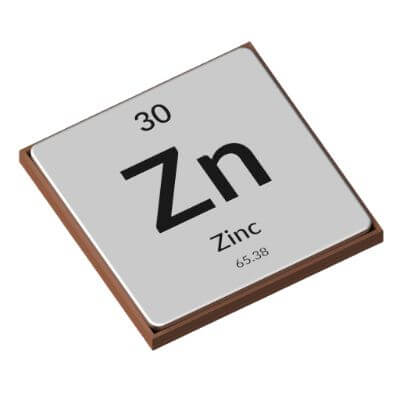
- Name: Zinc
- Symbol: Zn
- Atomic Number: 30
- Atomic Weight: 65.38 u
- Period: 4
- Group: 12 (zinc group)
34 Zinc Facts for Kids
- Zinc is a chemical element on the periodic table.
- Zinc is a metal that is brittle with a silver-gray color.
- Zinc is believed to have been named by the alchemist Paracelsus and named after the German word “Zinke” which translates to “prong, tooth”.
- Zinc was first discovered at least 3,000 years ago by Indian metallurgists in India.
- Zinc was first isolated in 1746 by German chemist Andreas Marggraf. It’s important to note that Marggraf is given credit for the first isolation of zinc, but Swedish chemist Anton von Swab at the time claimed he distilled zinc from calamine in 1742, four years before Marggraf.
- The symbol for zinc is Zn.
- The atomic number for zinc is 30.
- The standard atomic weight for zinc is 65.38 u.
- Zinc is a solid at room temperature.
- Zinc is in the post-transition metal element category on the periodic table.
- Zinc is a period 4 chemical element, which is the fourth row on the periodic table.
- Zinc is a group 12 chemical element, which is the zinc group.
- Zinc is in the d-block on the periodic table.
- The electron configuration for zinc is [Ar] 3d10 4s2.
- The electrons per shell for zinc are 2, 8, 18, 2.
- Zinc has five stable isotopes.
- The five stable isotopes for zinc are 64Zn, 66Zn, 67Zn, 68Zn, and 70Zn.
- The melting point for zinc is 787.15 °F (419.53 °C).
- The boiling point for zinc is 1665 °F (907 °C).
- According to the USGA, the worldwide mine production of zinc in 2017 exceeded 13.7 million tons.
- According to the USGA, the largest mines producing zinc in 2017 were in China with over 4.7 million tons.
- According to the USGA, China produced over 34% of the world’s supply of zinc in 2017.
- Based on data from the USGA, the world’s proven reserves of zinc exceeded 253 million tons as of 2017.
- Around 95% of all the zinc produced worldwide comes from sphalerite, a zinc sulfide mineral.
- Zinc is the fourth most popular metal in use around the world, only beaten by aluminium, copper and iron.
- Around 55% of the zinc used in the United States is for galvanizing iron and steel.
- Around 37% of the zinc used in the United States if for metal alloys, with 16% exclusively for brass and bronze.
- The compound zinc chloride (ZnCl2) is used as a wood preservative and a fire retardant for lumber.
- The compound zinc sulfide (ZnS) is used in luminescent pigments to help them glow-in-the-dark.
- The compound zinc sulfate (ZnSO4) is used in pigments, dyes and animal feed as a source of zinc.
- The compound zinc pyrithione (C10Hsub>8Nsub>2Osub>2Ssub>2Zn) is used in outdoor paint to prevent the growth of mildew and algae.
- Zinc is an essential trace element for all living organisms.
- The FDA’s Daily Value (DV) recommends males between 19 and 30 intake 11 milligrams of zinc a day.
- The FDA’s Daily Value (DV) recommends females between 19 and 30 intake 8 milligrams of zinc a day.
Additional Resources on Zinc
- Zinc (Zn) – Discover more about the chemical element zinc on the Los Alamos National Laboratory website.
- Zinc for Kids – Find more information about the chemical element zinc for kids on the Britannica Kids website.
- Zinc and Your Health – Learn about the benefits and/or risks of zinc to your health on the National Institute of Health website.
- Zinc – PubChem – Read more about zinc and the data behind it on the NIH PubChem website.
